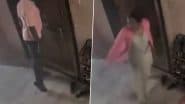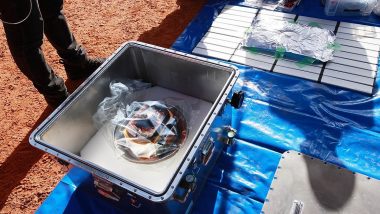Tokyo, December 8: A small capsule containing asteroid soil samples that was dropped from space by Japan's Hayabusa2 spacecraft and landed in the Australian Outback arrived Tuesday in Tokyo for research into the origin of the solar system and life on Earth.
The Japan Aerospace Exploration Agency said its capsule, tightly sealed and carefully stored in a container box, arrived in Japan on a flight from Australia, attended by a group of JAXA officials. Also Read | Bharat Bandh | Left Political Parties, Trade Unions Stop Trains at Bhubaneswar Railway Station : Live Breaking News Headlines Updates on December 8, 2020.
Capsule Containing Asteroid Samples Reaches Japan
Today (12/8) at 10:31 JST, the truck transporting the capsule arrived at the Sagamihara campus. At 11:27 JST, the container holding the capsule was brought into the Sagamihara Campus Research Laboratory Building and the transportation of the Hayabusa2 capsule was complete.
— HAYABUSA2@JAXA (@haya2e_jaxa) December 8, 2020
At the end of its yearlong journey from asteroid Ryugu, more than 300 million kilometers (190 million miles) from Earth, Hayabusa2 released the capsule Saturday from 220,000 kilometers (136,700 miles) in space, successfully sending it to land on a targeted area in a sparsely populated desert in Woomera.
The extremely high precision work at the end of Hayabusa2's six-year mission thrilled many Japanese. Also Read | Joe Biden Picks Black Ex-General Lloyd Austin to Lead Pentagon As Defense Secretary.
The box with the capsule inside is now being transported to JAXA's research facility in Sagamihara, near Tokyo, for analysis. Launched in December 2014, the unmanned Hayabusa2 spacecraft touched down twice last year on the asteroid Ryugu. Despite an unexpectedly rocky surface that even forced the mission's team to revise landing plans, the spacecraft successfully collected data and soil samples from two locations — on the surface and from underground.
Scientists say the samples, especially ones taken from under the asteroid's surface, contain data from 4.6 billion years ago unaffected by pace radiation and other environmental factors. They are particularly interested in studying organic materials in the samples to learn about how they were distributed in the solar system and if or how they are related to life on Earth.
The samples will be treated in a clean room at the Sagamihara facility to avoid any external impact, and the work is expected to start soon. After initial studies and curation in Japan, some of the samples will be shared with NASA and other international scientists for further study.
(This is an unedited and auto-generated story from Syndicated News feed, LatestLY Staff may not have modified or edited the content body)













 Quickly
Quickly





















